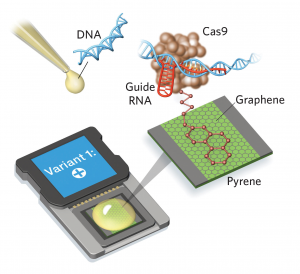CRISPR on a Chip
October 22, 2019 | Terry Sharrer

Digital DNA detection
First, affix a piece of graphene to a pyrene substrate. Then, load Cas9 and guide RNA molecules onto the graphene. When a purified, unamplified sample of DNA is inserted into this transistor, an electrical current activates the binding between the relevant sequence and the RNA, and a change in electrical current registers the match. This is how a researcher at the Keck Graduate Institute (Claremont, CA) developed a “CRISPR-Chip.” MORE
Image Credit: The Scientist and Keck Graduate Institute


